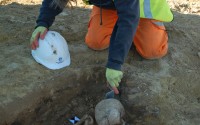The Bare Bones of Burials in Archaeology: a commercial Archaeologist’s View
- Date
- 22 May 2018
- Start time
- 7:30 PM
- Venue
- Tempest Anderson Hall
- Speaker
- David Williams, WYAS

The Bare Bones of Burials in Archaeology: a commercial Archaeologist’s Views on the challenges, rewards and what we learn
David Williams, Senior Project Manager, West Yorkshire Archaeological Services
Human remains can appear on types of archaeological sites and they provide both a challenging and rewarding experience for an archaeologists. The talk will provide an overview of how archaeologists deal with human remains and the real insight into the people that would have lived in the past. The remains can provide really useful information for an archaeologist and anyone who studies that past, but there are many steps and processes that are involved in exhuming the remains from the ground before an osteologist will look at them.
The talk will focus upon how we as archaeologists deal with the exhumation of a single unexpected burial to other known graveyards that require clearing. Having worked in commercial archaeology for over 13 years the talk will focus upon some of the individuals that I have excavated from across Yorkshire and the real impact that they have had upon me and colleagues. The challenges and rewards that human remains provide will be detailed and explored and a sometimes difficult but yet fascinating part of archaeology will be discussed.
Dave Williams has worked in commercial archaeology for over a decade, undertaking a variety of projects from large infrastructure schemes right down to small-scale investigations. He has worked on a variety of extensive rural and urban sites.
Member’s report
David Williams’ role is to manage archaeological excavations before building works start and his many fascinating photographs of burials from the Iron Age onwards illustrated a singular problem. Human burials are often found, in sometimes unlikely places, during digs. Archaeologists are not normally trained to deal with bodies and may need support to deal with what can be a quite unexpected psychological impact, particularly where children are involved. It also affects the excavation. When a body needs to be moved, an Exhumation Licence is required. This imposes such injunctions as treating the body with respect and also screening the grave for privacy – which can conflict with the public’s interest as well as the progress of the dig. If the body still has soft tissue, full safety equipment is necessary to guard against the transmission of dangerous diseases. Digs are documented and detailed drawings are made, but recent technical advances allow 3D images to be generated from photographs. In addition, family connections can now be deduced from DNA samples.
Rod Leonard